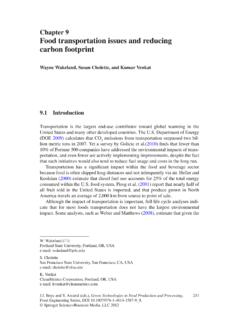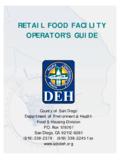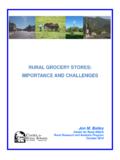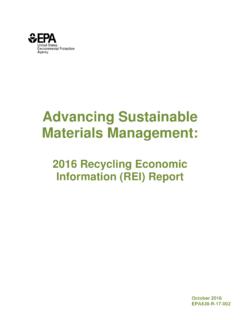Transcription of The role of producer organizations in reducing …
1 The role of producer organizations in reducing food loss and waste INTERNATIONAL YEAR OF COOPERATIVES ISSUE BRIEF SERIES FAO/Giuseppe Bizzarri, FAO/Paballo Thekiso, FAO/Olivier AsselinEvery year, an estimated billion tonnes roughly one-third of the food produced for human consumption worldwide is lost or The following figure shows that in industrialized countries, significant waste occurs at the consumption stage, while in low-income countries, food losses take place primarily during the early and middle stages of the supply chain (FAO, 2011).
2 1 food losses refer to the decrease in edible food mass available for human consumption throughout the different segments of the supply chain. In addition to quantitative losses, food products can also face a deterioration of quality, leading to a loss of economic and nutritional value. food waste refers to food losses resulting from decisions to discard food that still has value. food waste is most often associated with the behaviour of retailers, the food service sector and consumers, but food waste and losses take place all along food supply to retailingEuropeNorthAmerica,OceaniaIndus trializedAsiaSubsaharaAfricaNorth Africa,West &Central AsiaSouth &SoutheastAsiaLatin America050100150200250300 Per capita food losses and waste (kg/year)
3 , at consumption and pre-consumption stagesThe losses incurred in developing countries are largely due to infrastructural constraints related to poor transport, storage, processing and packaging facilities, in addition to capacity gaps that result in inefficient production, harvesting, processing and transport of food . Depending on the commodity and the local context, these activities which are key to reducing losses are often carried out by smallholder farmers or other actors operating close to the farm-gate, such as traders, collectors, agroprocessors and marketing cooperatives.
4 It is difficult for smallholders to ensure efficient delivery of produce to buyers because of their small-sized operations and their vulnerability when faced with environmental and market fluctuations. This situation contributes not only to food loss, but also to higher transaction costs, loss of income and increased food insecurity, reinforcing the overall argument for supporting producer organizations that foster the collective capacity of smallholder operations. FAO has been working closely with various forms of producer organizations at the federation and district levels across Africa, the Caribbean and the Pacific regions, to develop different mechanisms and tools for reducing losses early in the supply chain.
5 The following recommendations draw on the success factors and good practices for addressing food losses that have emerged from this work. BOX 1 Smallholders warehouse receipt system contributes to loss reduction in the Niger FAO/Giuseppe Bizzarri FAO/Giuseppe BizzarriThe FAO-supported Warehouse Receipt Systems Project in the Niger promotes the safe storage of food surpluses produced in Maradi and Dosso departments. The system ensures that food is stored properly so that losses are reduced, and enables smallholders to profit from changes in the value of stock, which can increase by as much as 30 to 40 percent four to six months after harvest.
6 The mechanism involves producer associations borrowing on behalf of farmers, against the farmers stored produce; local financial institutes lending to the farmer organizations , based on the value of the produce stored; and local warehouse managers/operators providing storage facilities. A fee is deducted from farmers loans to cover the costs of transactions. Recommendations Sustained dialogue with buyers: Remaining in constant dialogue with buyers not only helps agro-enterprises to manage the risks they face when buying from smallholders,1 but also contributes to producer organizations understanding of buyers sourcing decisions (FAO, 2012).
7 As well as increasing business between the parties, sustained dialogue also helps to reduce product rejection by buyers. FAO/Roberto FaiduttiBOX 2 reducing post-harvest losses of oil-palm in CameroonOne of the causes of Pamol Plantations high rejection rates of smallholder-supplied fresh oil-palm fruit was substandard quality due to premature harvesting. As part of an initiative to upgrade the business model, the company in collaboration with local producer organizations and supported by FAO trained smallholder suppliers in good harvest and post-harvest practices, and addressed smallholders grievances over late payments by introducing monthly payment schemes through local microfinance institutes.
8 This initiative has resulted in fewer rejections and improved income for smallholders. BOX 3 reducing post-harvest losses and improving smallholders income from cassava in CameroonThe fragmentation of smallholder supplies to the market was identified as one of the bottlenecks that needed to be addressed to improve competitiveness of the cassava chain in Cameroon. Following the establishment of quality control and logistics mechanisms run by local producer organizations with support from FAO wholesalers can now use public transport to pick up graded produce and make payments at agreed stops along the Akonolinga-Yaound highway.
9 These mechanisms have resulted in improved quality control, fewer product rejections by wholesalers and increased income for both producers and buyers. Coordination of supply to the market: producer organizations can help smallholders to reduce losses by coordinating production planning across farms and staggering production and harvesting schedules according to market needs. Box 1 provides an example of a warehouse receipt system, which can address market price fluctuations related to seasonal variations in supply and demand, resulting in fewer losses.
10 Coordination of financial service provision to avoid premature harvesting: Financial need often forces poor farmers to harvest produce early, lowering the nutritional and economic value of the crop. As described in Box 2, producer organizations can help reduce farmers need to harvest prematurely by identifying and coordinating financial services for households and farms. Organizational innovations for low-cost value addition: producer organizations can play an important role in adding value to and reducing losses of their members produce through organizational and management innovations, supporting activities such as production planning, sorting, grading and logistics (FAO, 2012).


















